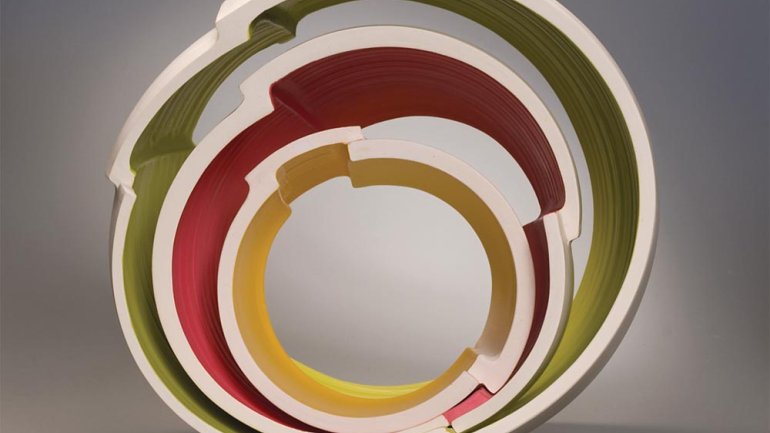More Ways Than One
More Ways Than One
Ceramist Anne Hirondelle dedicated decades to perfecting the vessel. Then she started taking it apart.
The first time I saw one of Anne Hirondelle’s clay vessels, I thought it was made of metal. Tall and mottled with a coppery glaze, the pitcher stood like a sentinel in a small exhibition of Northwest artists. I sneaked a quick pass of my hand over the pocked patina and marveled at the vessel’s heft, the power of its bones. Like Hirondelle herself, the piece embodied grace, gravity, and purpose.
Since that rainy evening in Port Townsend, Washington, nearly 15 years ago, however, the trajectory of Hirondelle’s work has taken some unexpected turns. No longer are her vessels created for the sole purpose of holding water, tea, or wine. In fact, some of her current works resemble liquid itself. Her surfaces no longer embellish the form; they define it. At 67, Hirondelle has exploited her medium beyond function, transforming clay into sculpture.
Hirondelle (her avian name means “swallow” in French) began as a production potter. After studying with Robert Sperry at the University of Washington in the 1970s, she embarked on perfecting functional forms. She quickly discovered the possibilities within those limitations, playing with scale and surface – birdlike bowls and huge triptych pitchers glowed with her signature soda-ash glaze. These pieces, as well as her current work, are now lavishly documented in Anne Hirondelle/Ceramic Art, published in March by the University of Washington Press. “Every new work appears warmly alive,” co-author Jo Lauria writes in her introductory essay, “and every new series feels animated by fresh ideas.”
Hirondelle’s aesthetic is a direct reflection of her life. She and her husband live in the same 1903 cottage they bought in 1976. Her stylish haircut (which she does herself) has had the same bowl shape, with the addition of a ponytail, since her 30s. Even her daily rituals are as predictable as a Buddhist monk’s: 7 a.m., three-mile walk with one of her myriad friends; 8 a.m., yoga; 10 a.m., studio; 4 p.m., three-mile walk with her husband. Oh, and she still doesn’t have voicemail, a cellphone, or access to the Internet. “Too much stimuli,” she says, and smiles.
Yet this ascetic lifestyle has generated work that is neither rote nor conventional. In fact, the slow, molten evolution of her art is more akin to a Theodore Roethke love poem: I knew a woman, lovely in her bones, / When small birds sighed, she would sigh back at them; / Ah, when she moved, she moved more ways than one: / The shapes a bright container can contain! Though staying true to the notion of vessel, Hirondelle’s career has been a conversation about stretching that definition – using teapot handles as architectural bridges in her diptychs or cutting a bowl in two, only to use half of it for a base, as in her Turnpools series.
In fall 2001, however, after a show at Seattle’s Foster/White Gallery, Hirondelle’s ideas about glazing came to a standstill. “I was restless,” she says. “The firing process was becoming too labor-intensive. Plus, the need to glaze was limiting my ideas. I needed to find a new way of finishing the work, something that would allow me to continue working in clay for another 20 or 30 years.” Several months later, she mounted a series of her new, unglazed pieces in a row on her studio wall. “Seeing all that naked white against the wall,” she recalls, “it was, ‘wow.’ ”
She discovered that stripping surfaces of adornment could embolden their shape. As glazing was cast aside, so too was her need to create pots. She began deconstructing and reconfiguring the vessel (as in the Re:Form and Remember series), reshaping what it means to contain. She began applying latex and acrylic paints. Her Abouturns – often displayed in a wall grid – are washed in Chinese red, cobalt blue, and butter yellow, resulting in a chorus of Dr. Seuss-like mouths.
Sometimes Hirondelle paints only a lip or, as in her Tumble series, an interior of a piece, leaving a lot of untouched white, emphasizing sculptural shadows within the caves of clay.
Today, Hirondelle has given herself permission to abandon the vessel altogether. In her Go Pillows series, only the backs of these rounded sculptures are painted, the hidden color fooling viewers into thinking the grid is backlit. In her new Re:Coil series, extruded lengths of clay interlace, Mobius-like, into a freestanding tangle of curves. (Shifting Roethke into present tense: She moves in circles and those circles move …) These supple shapes are made more playful by the primary-color palette, a huge departure for an artist who had never strayed from earth tones.
Once, years ago, a viewer commented that Hirondelle’s dark-sheened vessels weren’t exactly “pretty.” Hirondelle replied, “Well, I don’t make light pots!” (Frivolity has never been her way.) Ironically, her recent explosion into color and shape has imbued her work with buoyancy, as if in her sixth decade the artist is inhabiting her name, embodying the aerodynamic grace of a swallow’s bones. Hirondelle began with earth: Now she offers us light and air.
On March 29, co-authors Jo Lauria and Jake Seniuk are scheduled to discuss their recently published monograph on Hirondelle’s work at the 46th annual conference of the National Council on Education for the Ceramic Arts in Seattle.
Poet and art writer Christine Hemp produces and hosts The Hempsonian Institute of Higher Yearning, a public radio program that explores art, literature, and music.

